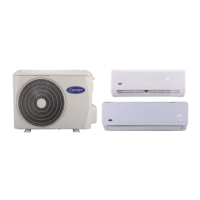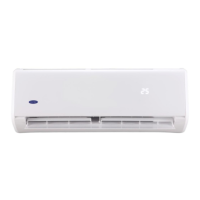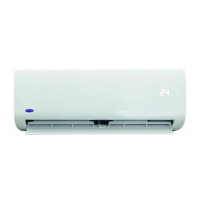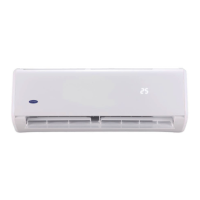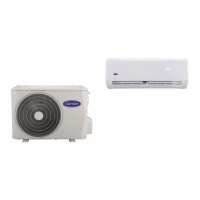7GB-13
6. REFRIGERANT PIPING CONNECTION
6.1 Safety Precautions707
WARNING
• All field piping must be completed by a
licensed technician and must comply
with the local and national regulations.
•
When the air conditioner is installed in a
small room, measures must be taken to
prevent the refrigerant concentration in
the room from exceeding the safety limit
in the event of refrigerant leakage. If the
refrigerant leaks and its concentration
exceeds its proper limit, hazards due to
lack of oxygen may result.
• When installing the refrigeration system,
ensure that air, dust, moisture or foreign
substances do not enter the refrigerant
circuit. Contamination in the system may
cause poor operating capacity, high
pressure in the refrigeration cycle,
explosion or injury.
•
Ventilate the area immediately if there is
refrigerant leakage during the
installation. Leaked refrigerant gas is
both toxic and flammable. Ensure there
is no refrigerant leakage after
completing the installation work.
Refrigerant Piping Connection Instructions
CAUTION
• The branching pipe must be installed
horizontally. An angle of more than 10°
may cause malfunction.
• DO NOT install the connecting pipe
until both indoor and outdoor units have
been installed.
• Insulate both the gas and liquid piping to
prevent water leakage.
Step1: Cut pipes
When preparing refrigerant pipes, take extra
care to cut and flare them properly. This will
ensure efficient operation and minimize the
need for future maintenance.
1. Measure the distance between the
indoor and outdoor units.
2. Using a pipe cutter, cut the pipe a little
longer than the measured distance.
CAUTION
DO NOT deform pipe while cutting. Be
extra careful not to damage, dent, or
deform the pipe while cutting. This will
drastically reduce the heating efficiency
of the unit.
1. Make sure that the pipe is cut at a perfect
90° angle. Refer to Fig. 6.1 for examples of
bad cuts
Oblique
Rough
Warped
90°
Fig. 6.1
Step 2: Remove burrs.
Burrs can affect the air-tight seal of
refrigerant piping connection. They must be
completely removed.
1. Hold the pipe at a downward angle to
prevent burrs from falling into the pipe.
2. Using a reamer or deburring tool,
remove all burrs from the cut section
of the pipe.
Pipe
Reamer
Point down
Fig. 6.2
Step 3: Flare pipe ends
Proper flaring is essential to achieve an
airtight seal.
1.
After removing burrs from cut pipe, seal
the ends with PVC tape to prevent
foreign materials from entering the pipe.
2.
Sheath the pipe with insulating material.
3.
Place flare nuts on both ends of pipe.
Make sure they are facing in the right
direction, because you can’t put them
on or change their direction after flaring.
See Fig. 6.3
Flare nut
Copper pipe
Fig. 6.3
NOTE
For R32 refrigerant models, the pipe connection
points must be placed outside of room.

